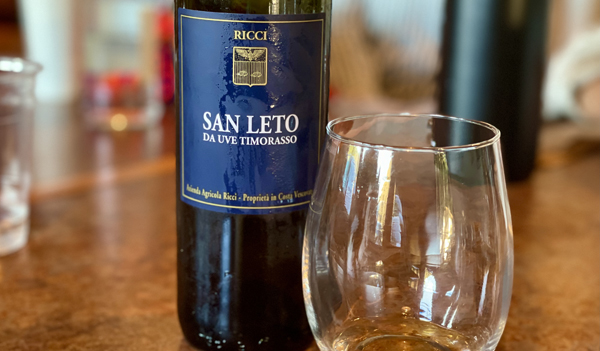2018 Daniele Ricci, Timorasso San Leto, Costa Vescovado, Colli Tortonesi, Italy.
One of the most interesting wines I tasted recently at a blind Piemonte tasting was the Ricci Timorasso, a rare native white varietal that has made a huge impact in the region over the last 10 years and where it has now a full DOC, known as Derthona in the Colli Tortonesi zone of Piemonte. Timorasso, which was almost used exclusively for Grappa production, which almost went extinct in the 70s and 80s, and its modern-day existence and success is down to one man Walter Massa, who singlehandedly brought it back. This deep golden hued Daniele Ricci San Leto Timorasso version comes from all organic vines that were planted in 1989 and 1992 has a medium full bodied palate with surprising freshness and slightly reductive with loads of mineral tones, phenolic grip, layers of lemony citrus, peach/apricot, quince and green apple fruits. Uniquely, the winery says, the Ricci San Leto undergoes three days of skin maceration and natural fermentation in cool stainless steel without any pump-overs so not to extract any bitterness from the skins. The wine is then aged in non toasted 700L acacia barrels for a minimum of twelve months, allowing richness of texture without oak getting in the way of the purity of terroir and varietal character. Timorasso has plenty of acidity, stony/flinty notes and iodine which has keep things vibrant here and age has given, as the winery notes as well, secondary and tertiary evolution with it now showing nutty almonds, orange peel, chamomile, herbs and delicate florals. By the way, the area was first noted for quality wine by the Romans, hence the use of the Derthona name, which the town was called during those ancient times, with the DOC being officially granted in 2020.
The Ricci winery, which I was first introduced to 10 years ago with their intriguing Barbera, is based, as mentioned above, in the Costa Vescovado area of the Colli Tortonesi, known historically as Cascina San Leto, before the Ricci family became involved. It was originally purchased in 1929 by Damiele Ricci’s grandmother Clementina and Grandfather Carlo, as an agricultural farm, where alongside cattle and wheat, they planted the farm with local grapes, mostly Timorasso with smaller amounts of Barbera and Croatina. Timorasso had, as noted before, all but been abandoned since it was nearly wiped by phylloxera, which devastated most of the area’s vines in late 1800s and never truly replanted. Daniele and his father did not grow up on the farm but rediscovered it years later and began the journey to becoming one of the main proponents of Timorasso, after being inspired by the efforts of Massa, reinvigorating and reinterpreting it in their way, as seen here with the skin fermentation and acacia wood aging. For both his Timorasso and Cortese white grapes, Daniele has employed these macerations on the skins, with some even seeing underground amphorae, similar to Georgian techniques, which the winey explains, eliminating the use of selected yeasts, added sulfur and not having to clarify the wine. While now widely admired for his various expressions of Timorasso, Ricci, as I said, has also gotten attention for their red wines, made mostly from Barbera, but also including the rare and native Croatina grape. The terroir here includes ideal ripening conditions with southern exposures and the Tortonian marl based soils, that are mineral rich adding a complex additional influence here, making for wonderful distinctive wines, as seen here. I really was thrilled by this wine, thankful that my friend Germaine Esquivel, sommelier at the famous Post Ranch Inn in Big Sur, bright this wine to our tasting!
($70 Est.) 94 Points, grapelive
